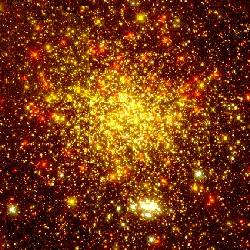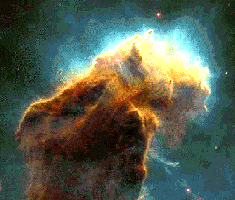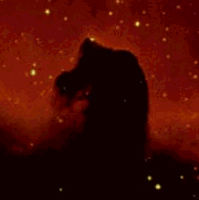|
VII. BEYOND THE SOLAR SYSTEM: THE MILKY WAY
Stars
When we look into the night sky, it is populated with star systems of all
shapes, sizes and colors. Some are supergiants hundreds of times bigger
than the sun, some are puny, no bigger than the Earth. Some are blue some
are red, they come in many colors. Some are solitary, the majority (maybe
as many as 75%) come in multiple star systems. Some have planets, others
do not. Some stars are relatively stable, others vary in size and brightness.
The brightness that we see here on earth called the apparent magnitude
is a function of two things: the actual amount of light that the star puts
out and its distance from the earth. The apparent magnitude scale of stars
was first established by Hipparchus, a hellenistic astronomer. His
original magnitude scale was qualitative. Today we have extended and refined
the scale into a quantitative scale and a first magnitude star is 2.5 times
brighter than a second magnitude star, a sixth magnitude star is 100 times
dimmer than a first magnitude star, etc.. The brighter the star,
the lower the number. In order to be able to compare stars without
the influence of distance, astronomers also talk about how bright a star
would be at a standard distance (taken to be 10 parsecs or 32.6 LY). We
call this absolute magnitude. For example the sun has an apparent
magnitude of -26.7, but an absolute magnitude of +4.8. Because stars do
not put out all of their energy in the visible spectrum, we use a third
measure, luminosity, or the total amount of energy a star puts out.
There are six luminosity classes. It turns out that two factors affect
luminosity, surface area and surface temperature.
|
LUMINOSITY CLASSES
|
It further turns out that |
|
Ia
|
Bright Supergiant |
|
Ib
|
Supergiant |
|
II
|
Bright Giant |
|
III
|
Giant |
|
IV
|
Subgiant |
|
V
|
Main Sequence Star |
|
|
 Open
cluster Open
cluster |
 Globular cluster
Globular cluster |
| Stars are not scattered evenly in space;
they tend to come in clusters. Some clusters are open, often
rich in bright, bluish younger stars. These are more commonly found within
the star and dust lanes of the Milky Way. Other clusters exist in, or surround
the center of the galaxy in a halo, much as comets surround the plane of
the solar system. These globular clusters with up to a million stars
or more are rich in older, more yellow stars. |
 
The Eagle Nebula: a bright nebula
The Horsehead Nebula: a dark nebula |
| Between the star systems lies interstellar
space. This is not a vacuum devoid of matter, but space that contains dust
and gases. In many places this dust and these gases are tenuous; in other
places they are concentrated into nebulae (clouds). Some of these
nebulae are close to stars and will fluoresce (glow) from the energy of
nearby stars. Others will simply reflect the light of these stars. Both
of these nebulae are called bright nebulae because they give off
light. Other, often dense, nebulae, far away from bright stars will actually
block starlight. These are called dark nebulae. |
Since Hubble, we have come to understand that these stars, nebulae and
clusters are not evenly and randomly distributed across the universe, but
that they clump up (as does all matter) into larger aggregates called galaxies. |





